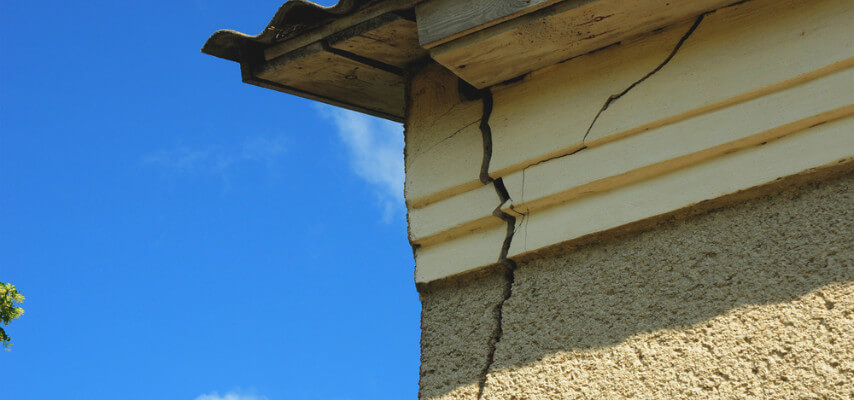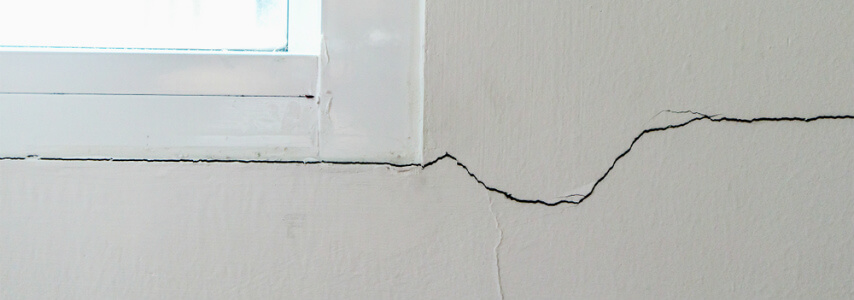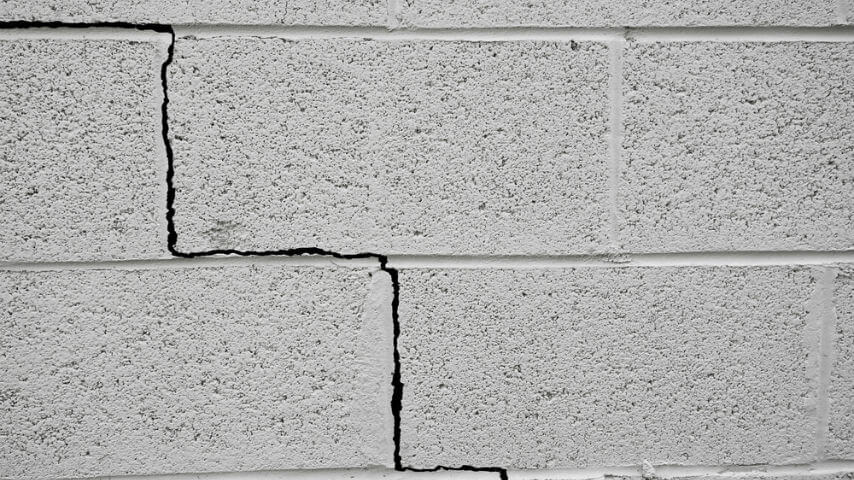Wall and ceiling cracks are often concerning for homeowners, but they are common in houses of all ages. Some wall cracks are completely harmless, nothing more than surface-level blemishes that can be easily repaired. However, certain types of cracks are indicators of severe structural damage – you can learn more about what happens if you don’t fix foundation issues here.
It’s hard to tell the severity of a crack just by looking at it, so it’s a good idea get an expert’s opinion before trying to repair it yourself. This guide will teach you about the different types of wall cracks so you can determine whether to seek professional help.
Call URETEK ICR Gulf Coast for expert foundation repair in Houston, TX today.
Do Cracks in Walls Mean Foundation Problems?
A small crack in your wall doesn’t necessarily mean you have a serious foundation problem on your hands. Minor cracks that are only surface level are often harmless and can be patched with a little drywall putty and a new coat of paint. However, more severe cracks require a professional’s help to get to the root of the problem.
Let’s look at some common types of wall cracks to see which ones indicate foundation issues.
Types of Cracks in Walls and Ceilings
These seven types of wall cracks can help you narrow down potential causes. Some cracks are typically superficial, while others typically go hand-in-hand with deeper problems.
Horizontal Cracks
Horizontal cracks in drywall are often indicators of foundation problems. These cracks can be caused by poor soil below the foundation, water damage, and more. Horizontal cracks in concrete walls often indicate serious issues as well.
If you notice a horizontal gap between your foundation and wall, this is a strong sign that your foundation has problems. You will need to repair your foundation to prevent the gap from widening further.
Vertical Cracks
Vertical cracks in walls typically indicate house settling. Since vertical cracks run in the same direction as drywall, they are typically considered less serious than horizontal cracks.
Stair-Step Cracks
A stair-step crack looks exactly how it sounds — a flight of stairs going diagonally across your wall. These cracks are cause for concern, as they are a very common symptom of foundation problems. Stairstep cracks can be found on brick walls outside of your home or on cinder block foundation walls in unfinished rooms of your house.
Door and Window Cracks
Cracks in walls around windows can appear in houses of all ages. They can be caused by improper installation of windows or natural settlement. When a house settles over time, the plaster can become weak, resulting in cracks around windows and doorframes.
If you notice a widening crack between your door frame and wall, this is a stronger signal that your foundation is significantly shifting. Resolving this type of crack in your home will require professional help.
Bowed Ceiling Cracks
Bowed ceiling cracks can be a sign of structural problems. A ceiling may crack or bow due to excessive weight on the floor above, such as a pool table or hot tub. This type of ceiling crack can also be the result of an improperly sized ceiling joist or a damaged ceiling joist/truss. You may want to contact a professional immediately if you observe bowed ceiling cracks.
Spiderweb Cracks
Small spider web cracks on your ceiling can indicate a thick drywall application. Usually, a thin drywall compound is used to create textured ceilings. This compound shrinks as it dries, so when applied too thickly, tiny spiderweb-like cracks may appear.
Nail-Popping
Nail-popping isn’t technically categorized as “cracking,” but the two phenomena are closely related. If you notice small, circular bumps or cracks in your wall or ceiling, you might have drywall nail pops. In homes that are only a year or so old, these cracks probably aren’t cause for concern. It’s normal for new homes to experience nail popping due to wood shrinkage.
However, in older homes, nail pops can be a sign of foundation settlement. In addition, nail popping accompanied by other wall cracks is a bad sign. Whether you have a couple of nail pops or dozens, its best to deal with them quickly before they get out of hand.
What Causes Cracks in Walls and Ceilings?
Why do walls crack? The cracks in your wall could have been caused by several things. House settling, earth movement and poor construction can all leave your drywall riddled with cracks, but those aren’t the only causes. Let’s look at some of the most common reasons for cracks in walls.
Expected Settling
Small cracks due to minor settling are to be expected in houses as they get older. Homeowners might notice hairline cracks above door frames and windows. Foundations shift slightly over the years, and most of the time this movement is harmless. However, it may result in small settling cracks around your house. Luckily, these house settling cracks can be easily repaired and gone in no time.
New Home Settling
Newly-built homes are often prone to cracks due to settling. The fresh lumber used to build new houses contains moisture, causing the lumber to shift over time as it dries. This slight movement can result in minor wall cracks. To ensure the wood is dry and settling is complete, you should wait a year before doing any crack repair.
Leaving House Vacant
Homes that are left vacant for months at a time can experience drywall cracks. Climate control regulates the temperature and humidity levels in your house, keeping your drywall in good shape. When a home isn’t climate controlled, the drywall can expand and contract, causing hairline cracks in walls and ceilings.
Poor Drywall Taping
A thin straight ceiling crack might be the result of poor drywall taping. These cracks are often due to improper installation. If the wrong type of drywall mud is used in the taping process or not enough is used, drywall cracks may appear.
Leak
If you notice discoloration on your internal wall cracks, your home might be experiencing water damage. A leaky window or roof can lead to moisture getting into your walls, causing drywall damage that results in cracking with yellow or brownish stains.
Structural Foundation Problems
While some cracks in your wall can be solely cosmetic, others can indicate foundation issues. Structural cracks in walls are serious and should be repaired immediately, so it’s important that homeowners know how to identify them.
Cracks That Likely Indicate Foundation Damage
- Cracks wider than 1/4 inch
- Unusually long horizontal cracks
- Multiple cracks all over your home
- Large diagonal cracks around doorframe corners
- Cracks on the second story of your home
- Interior and exterior wall cracks
Contact a professional immediately if you suspect structural foundation problems.
How to Repair Cracks in Walls and Ceilings
While DIY foundation crack repair might be tempting, it’s always best to get a professional’s opinion. If you suspect your wall cracks are due to structural issues, reach out to a reputable foundation repair technician immediately.
URETEK ICR Gulf Coast is a dependable provider of home repair and consultancy services based in Houston, Texas. Since 2000, we have offered a range of remedial services to 1000+ clients across the country. Our Houston foundation remediation services include both foam foundation repair and pressed piling foundation repair methods depending on your unique needs.
To get started with your foundation repair, contact us online today, or call us at 281-894-4990.




